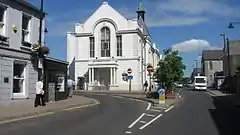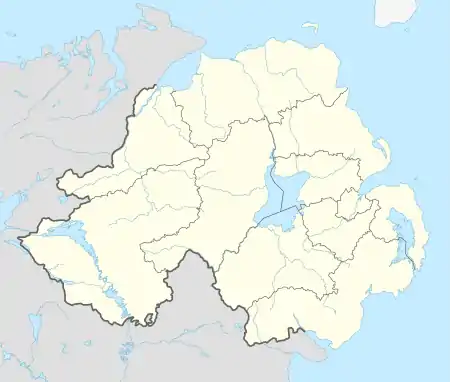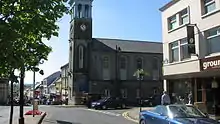Ballymoney
Ballymoney (from Irish: Baile Monaidh, meaning "townland of the moor"[3] [ˈbˠaːlˠaːˈmˠɔnˠɪ]) is a small town and civil parish in County Antrim, Northern Ireland. It is within the Causeway Coast and Glens Borough Council area. The civil parish of Ballymoney is situated in the historic baronies of Dunluce Upper and Kilconway in County Antrim, and the barony of North East Liberties of Coleraine in County Londonderry.[4] It had a population of 10,402 people in the 2011 Census.[5]
| Ballymoney | |
|---|---|
 Ballymoney town hall | |
 Ballymoney Location within Northern Ireland | |
| Population | 10,402 (2011 Census) |
| • Belfast | 48 mi (77 km) |
| District | |
| County | |
| Country | Northern Ireland |
| Sovereign state | United Kingdom |
| Post town | BALLYMONEY |
| Postcode district | BT53 |
| Dialling code | 028 |
| Police | Northern Ireland |
| Fire | Northern Ireland |
| Ambulance | Northern Ireland |
| UK Parliament | |
| NI Assembly | |
| Website | www.ballymoney.gov.uk |
Ballymoney has expanded in recent years and many new houses have been built. This is primarily as a result of high house prices in the Coleraine/Portstewart/Portrush 'Triangle' areas shifting first-time buyers to the less expensive Ballymoney area. Ballymoney is located on the main road between Coleraine and Ballymena, with good road and rail connections to the main cities in Northern Ireland, Belfast and Derry.
The Ballymoney area has the highest life expectancy of any area in Northern Ireland, with the average male life expectancy at birth being 79.9 years and 83.8 years for females in years between 2010 and 2012.[6] Conversely, it was revealed in 2013 that Ballymoney residents are more likely to die from heart disease than anywhere else in Northern Ireland.[7]
The town hosts the Ballymoney Drama Festival, the oldest drama festival in Ireland, which was founded in 1933. The town also hosts the Ballymoney Show, which is one of the oldest agricultural shows in Northern Ireland and was founded in 1902.[8]
History
.jpg.webp)
The Troubles
For more information see The Troubles in Ballymoney, which includes a list of incidents in Ballymoney during the Troubles resulting in two or more fatalities.
Politics
Ballymoney district is part of the Causeway Coast and Glens Borough Council. In 2014, the residents elected 3 Democratic Unionist Party, 2 Ulster Unionist Party, 1 Traditional Unionist Voice and 1 Sinn Féin councillors.
Demography
On Census day (27 March 2011) there were 10,402 people living in Ballymoney (4,354 households),[5] an increase of 15.3% on the Census 2001 population of 9,021.[9] Of these:
- 19.75% were aged under 16 years and 16.91% were aged 65 and over;
- 52.84% of the usually resident population were female and 47.16% were male;
- 76.23% belong to or were brought up in a 'Protestant and Other Christian (including Christian related)' faith and 17.17% belong to or were brought up in the Catholic Christian faith;
- 73.34% indicated that they had a British national identity, 28.11% had a Northern Irish national identity and 6.78% had an Irish national identity (respondents could indicate more than one national identity);
- 39 years was the average (median) age of the population;
- 32.05% had some knowledge of Ulster-Scots and 4.01% had some knowledge of Irish (Gaelic).
Buildings of note

Ballymoney is one of the oldest towns in Ireland with many buildings of historic note in the town centre.[10]
- An old church tower dating from 1637 is the town's oldest surviving building.
- Another striking feature is the town clock and Masonic hall, built in 1775 by the 6th Earl and 2nd Marquis of Antrim. The hall was used as a market house, courthouse, town hall and school.
- The town hall was erected in 1866.
People
Arts and Media
- Patrick Boyle (1905–1982), novelist.
- George Shiels (1881–1949), Popular playwright of early 20th century.
- Jimmy Young (1918–1974), a successful comedian, was born in Ballymoney.
Politics
- J.B. Armour (1841–1928), cleric, educationalist and Home Rule activist.
- George Macartney, 1st Earl Macartney (1737–1806) of Lissanoure, first British Ambassador to China in 1772.
- Thomas McKean (1734–1817), a prominent figure in the American Revolution, was the son of an emigrant from Ballymoney.
- Sir William Moore (1864–1944), Unionist politician and judge.
- William Robinson (1823–1912), Conservative Ontario politician.
- John Pinkerton (1845–1908), Home Ruler and Irish Parliamentary Party MP.
- John Robb, surgeon and former member of Seanad Éireann.
Sports
- Adrian Archibald (1969–), motor cycle racer.
- Stephen Carson (1980–), former Northern Ireland Under-21 international footballer, who plays for Coleraine in the IFA Premiership.
- Peter Chambers (1990–), rower; Silver medal in the men's lightweight four at the 2012 Summer Olympics.[11]
- Karen Corr (1969–), pool and snooker player.
- Joey Dunlop (1952–2000), known as the "King of the Road", was five times World Motorcycle Champion with 24 Ulster Grand Prix wins, 13 North West 200 wins and 26 Isle of Man TT wins. He was killed while racing in Estonia in 2000. A statue of Dunlop stands in the town.
- Robert Dunlop (1960–2008), motor cycle racer, Joey Dunlop's brother. One time record holder for the most North West 200 wins (15) until surpassed by Alistair Seeley.
- Mabel Harrison (1886-1972), golfer, died at Ballymoney
- James Hopkins (1901–1943), professional footballer.
- Ken McArthur (1881–1960), 1912 Olympic Gold Medalist, men's marathon.
- Gareth McAuley (1992–), sport shooter
- Bridget McKeever (1983–), a former Ireland women's field hockey international.
- Jim Platt (1952–), former Middlesbrough and Northern Ireland goalkeeper.
- Damien Quinn (1980–), captain of the Antrim senior hurling team.
- Chris Turner (1987–), former Northern Ireland Under-21 international footballer, currently plays for Shamrock Rovers in the League of Ireland.
- Davy Tweed (1959–), rugby player, Unionist politician
- Gary Kelly (1989-), Bowls World Cup Singles champion
Education
Nursery Schools
- Ballymoney Nursery School
- Sandcastles
Primary schools
- Ballymoney Primary School
- Ballymoney Primary School, also known as Ballymoney Model,[12] is situated at the top of the North Road and holds approximately 360 pupils each year. The school is within the Northern Eastern Education Library Board area.
- The school is one of the largest within Ballymoney, housing eleven classrooms running from P1 to P7. It also has a large dinner hall, assembly hall, and a computer room. The school has a library and a classroom for special needs children.
- Historically, Ballymoney Primary has been a predominately protestant school, but was scheduled to be integrated in September 2009 following a very narrow vote in favour of the idea.
- Ballymoney Primary's principal is Mr. G. McVeigh, while the vice principal is Mrs. Herron. And a new 2013 principal Mrs. Jamison
- Garryduff Primary School
- Garryduff primary school is for pupils aged 4–11, it is located on the Garryduff road approximately 3 miles out of Ballymoney it has got a new extension with a new multi-purpose hall and a new classroom. The current principal is Miss Tannahill.[13]
- Landhead Primary School
- Landhead Primary School is a primary school for pupils aged 5 to 11 years, located on the Kilraughts Road, close to Ballymoney Rugby Club.[14]
- In 2004 the Sunday Mirror reported on the school's cat "Tigger". The cat has since featured on local news and radio programmes.[15]
- Leaney Primary School
- Leaney Primary School is located near Ballymoney High School, on Intermediate Road, approximately 1 mile from the town centre. The school for children aged 4 to 11, is a part of the Eco-Schools programme which aims to raise pupils awareness of sustainable development issues. The current principal is Miss V Moorhouse.[16]
- Lislagan Primary School
- Lislagan Primary School is located about three miles from Ballymoney, in a rural location.[17] It is a controlled school for girls and boys aged from 3 to 11. Enrollment has risen steadily over the last five years and currently stands at 94.[18] It is within the North Eastern Education and Library Board area.
- St. Brigid's Primary School
- St. Brigid's Primary School is located in Castle Street.[19]
Secondary schools
College
- Northern Regional College, Ballymoney campus
Transport
- Ballymoney railway station opened on 4 December 1855, and was closed to goods traffic on 4 January 1965.[20] The refurbished railway station was opened in May 1990. It was one terminus of the Ballycastle Railway, a narrow gauge railway which ran 17 miles connecting Ballycastle to Ballymoney, on the Belfast and Northern Counties Railway (BNCR), later Northern Counties Committee (NCC), main line to Derry, and closed in July 1950.[21]
Industry
Media
The Ballymoney Chronicle was established in 1844. It is the largest selling weekly newspaper in the North Coast and the second largest weekly newspaper in Northern Ireland.[22]
Town twinning
- Benbrook, Texas, United States
- Vanves, France
- Douglas, Isle of Man[23]
See also
References
- Know_as=Peters_Back_yard Bellymoney daes Burns proud – Ullans Speakers Association
- Placenames Database of Ireland
- Place Names NI
- "Ballymoney". IreAtlas Townlands Database. Retrieved 20 April 2015.
- "Census 2011 Population Statistics for Ballymoney Settlement". Northern Ireland Statistics and Research Agency (NISRA). Retrieved 7 August 2019.
- Chartered Society of Physiotherapists (Microsoft Excel spreadsheet file). Archived 12 March 2007 at the Wayback Machine
- "Ballymoney 'worst place in NI' for heart disease" BBC News
- "Ballymoney Show". Ballymoney Show. Retrieved 10 November 2015.
- "Census 2001 Usually Resident Population: KS01 (Settlements) - Table view". Northern Ireland Statistics and Research Agency (NISRA). p. 1. Retrieved 7 August 2019.
- "Work ethic brings long life in Co Antrim's Tír na nÓg", Irish News, 13 August 2008
- "Peter Chambers". www.worldrowing.com. International Rowing Federation. Retrieved 22 June 2018.
- "Ballymoney Model Integrated Primary School". Retrieved 21 May 2020.
- "Garryduff Primary School". Retrieved 21 May 2020.
- "Landhead Primary School". Retrieved 21 May 2020.
- "Sunday Mirror". Archived from the original on 24 September 2015. Retrieved 2 July 2009.
- "Leaney Primary School". Retrieved 21 May 2020.
- "Lislagan Primary School". Retrieved 21 May 2020.
- School Inspection Report, January 2006 Archived 29 September 2007 at the Wayback Machine
- "St. Brigid's". St. Brigid's Primary School. Retrieved 21 May 2020.
- "Ballymoney" (PDF). Railscot – Irish Railways. Archived (PDF) from the original on 26 September 2007. Retrieved 27 August 2007.
- Baker, Michael HC (1999). Irish Narrow Gauge Railways. A View from the Past. Ian Allan Publishing. ISBN 0-7110-2680-7.
- "Ballymoney Chronicle". Archived from the original on 15 January 2018. Retrieved 14 January 2018.
- Douglas Borough Council Archived 14 July 2009 at the Wayback Machine
External links
| Wikimedia Commons has media related to Ballymoney. |
| Wikivoyage has a travel guide for Ballymoney. |
- . Encyclopædia Britannica. 3 (11th ed.). 1911.
- Ballymoney Borough Council.
- Visit Ballymoney.
- Culture Northern Ireland website.

